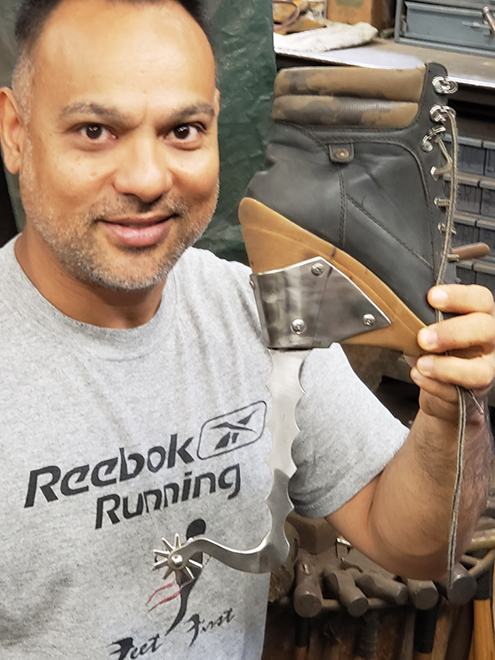
Even the best horses “cheat” by overthinking and anticipating what’s coming next or because they’re just plain lazy. Riders rely on their legs, and their spurs, to remind to stay focused or to ask for a speed change or maneuver. Wayne, New Jersey Reining competitor Fred Win was born with a congenital birth deformity that made his right leg six and a half inches shorter than his left.
Early during his mother’s pregnancy – before she even knew she was pregnant – she was diagnosed and treated for malaria. The potent medications were known for causing deformities.
“Lucky for me the powerful medicine only affected my thigh. It’s a miracle that my lower leg was attached,” he said. “That medicine is the equivalent of shaking up an egg and babies can be born with toes where their nose is supposed to be or they could die.”
His right leg has no thigh or knee. The lower part of his leg attaches to his hip. In dressage, the discipline he previously competed in and continues to ride allows the use of a riding whip. But whips and crops aren’t permitted in reining.
“Every show I was taking a risk every time we made a right to left lead change,” Win said. “It was also difficult on the circles because the horse gets thinking about a lead change even when they shouldn’t.”
His trainer Dean Brown, the National Reining Horse Association’s (NRHA) newest $1 million rider, and Bob Santagata owner of Santa Hill Ranch in Campbell Hall, New York knew Win needed a spur. Brown tried fixing a metal ball with a rubber end to Win’s boot, but it just bounced off the horse’s belly, according to Santagata.
“We’ve worked with Ray Maheu on a lot of our bits and spurs,” Santagata said. “I knew if anyone could do something, he could.”
Maheu invited Win to his workshop in Pawling, New York and his mechanical mind started churning immediately. Win sat aboard Maheu’s horses to be measured. Candy Maheu remembers watching the process and being amazed by Ray’s use of wire to determine which angles would work best.
“I took his boot and turned a piece of metal around the bottom of the heel. Then I welded a plate onto the heel so that I could weld an extension on to that,” Maheu said. “Then I had to get the right angle on the spur. I got a sharpie pen, marked it, took it into the shop and tack welded. When he tried it on it wasn’t quite right so I broke it off, turned it some more and got it just perfect.”
Maheu scalloped the six-inch extension from the bottom of the heel so that the spur also had aesthetic appeal. He sent Win home to test the spur on his own horses before the silver and engraving were applied.
“I’m thinking OK this is just a spur, but when I saw it I’m like oh my God this is so good. Even on my good side, my spur wasn’t properly fitted and not hitting in the right spot,” Win said. “I feel so powerful, it’s like having a leg. I can lift my horse’s shoulder when I go to show and I’m more confident in every circle because I know if my horse leans on me and tries to pop a lead change, I have something to push back with.”
The intent was for Win to bring the spur back for the finishing touches. But it’s been working so well, that Win hasn’t wanted to part with it. Since riding with Maheu’s spur, Win dominated the Non-Pro division at the Eastern Pennsylvania Reining Horse Association show in September. There he won the Intermediate and the Limited Non-Pro aboard Friday night sailing.

He’s continued that success at the Congress, placing sixth in the Non-Pro with a 215.5 and winning the Congress Para-Reining with a 217. He can’t wait to use the spur the Congress Freestyle competition and then the Central New York Reining Horse Association Derby later in October.
“Now he can change leads like everybody else,” Santagata said. “It looks pretty wild, the people at the bit checks don’t know what to make of it because they’ve never seen anything like it.”
Once the show season is over, he’ll hand it back to Maheu for the finishing touches.
“It makes me feel good that he appreciates the work I’ve done for him,” Maheu said. “It’s been life-changing for him.”
Win started his riding career as a young boy in his home country Myanmar, the southeast Asian country formerly known as Burma. About age 6, he climbed out the window of a three-story building and down to the ground to see a pony. He rode every chance he got, but it wasn’t until age 15 that he got his first horse. His father bought him a 3-year-old, who he trained to jump and perform tricks.
“I competed and won against able bodied riders,” he said.
At age 23 he came to the United States to study political science. He started taking dressage lessons and competing at United States Dressage Federation shows (USDF). He went on to law school and took a break from horses while repaying his student loans. He started developing a passion for Reining after participating in a Ride the Reiner demonstration at the 2013 American Quarter Horse Association World Championship Show held in Oklahoma City, Oklahoma and bought his first Reining horse in 2016.”It’s funny because at first I was attracted to it because of the speed, I wanted to go fast,” he said. “But I’ve since learned it’s about controlled speed and making it pretty.”



You must be logged in to post a comment Login